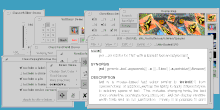NeWS
| Original author(s) | James Gosling, David S. H. Rosenthal |
|---|---|
| Developer(s) | Sun Microsystems |
| Initial release | October 1986 |
| Operating system | SunOS |
| Type | Windowing system |
NeWS (Network extensible Window System) is a discontinued windowing system developed by Sun Microsystems in the mid-1980s.[1] Originally known as "SunDew",[2] its primary authors were James Gosling and David S. H. Rosenthal. The NeWS interpreter was based on PostScript (as was the later Display PostScript, although the two projects were otherwise unrelated) extending it to allow interaction and multiple "contexts" to support windows. Like PostScript, NeWS could be used as a complete programming language, but unlike PostScript, NeWS could be used to make complete interactive programs with mouse support and a GUI.
Design
NeWS started by implementing a PostScript interpreter running in a cooperative multitasking fashion, since, unlike PostScript in a printer, NeWS would be displaying a number of PostScript programs at the same time on one screen. It also added a complete view hierarchy, based on viewports known as canvases, and a synchronous event distribution system, supporting events, interests, threads and monitors.
Like the view system in most GUIs, NeWS included the concept of a tree of embedded views along which events were passed. For instance, a mouse click would generate an event that would be passed to the object directly under the mouse pointer, say a button. If this object did not respond to the event, the object "under" the button would then receive the message, and so on. NeWS included a complete model for these events, including timers and other automatic events, input queues for devices such as mice and keyboards, and other functionality required for full interaction. The input handling system was designed to provide strong event synchronization guarantees that were not possible with asynchronous protocols like X.[3]
To support user interface widgets, NeWS expanded the original PostScript
NeWS included several libraries of user interface elements (

The best example of such a library is TNT (The NeWS Toolkit) which Sun released in 1989. Sun also shipped an earlier "Lite" toolkit intended for example purposes and making small programs.
Porting
Although adoption was never widespread, several companies and universities licensed NeWS and adapted it for various uses, creating both commercial and non-commercial ports.[4]
- 4Sight to replace their proprietary MEXwindowing system.
- Grasshopper Group created a Macintosh port called MacNeWS.
- Parallax extended it to be able to deal with live video.
- Architech Corporation ported NeWS to OS/2,[5] calling it NeWS/2
- Columbia University ported it on HP 9000 series 3000
- Los Alamos National Laboratory ported it on a Cray XMP-24
- TGV ported X11/NeWS on a VAXstation 2000 running VMS
- Wedge Computer Inc. ported it to MacOS
- Whitechapel ported it to their MIPS workstations[6]
- Acorn ported it to their computers
- Ameristar ported it on the Amiga 2000
- Alliant ported X11/NeWS on their Visualization[7] minisupercomputers
- University of Michigan ported it on Apollo workstations, in monochrome mode[8]
- Pixar ported it to their Image Computer[9]
Applications
The
A commercial drawing program, Altsys Virtuoso, was produced for NeWS; it was a port of FreeHand with additional functionality that took advantage of the PostScript environment. Unfortunately Sun announced the end of support for NeWS just as Virtuoso became ready to ship.
Competition with X Window System
Compared to X, NeWS was vastly more powerful,[citation needed] but also slower (especially for local connections). The C API was very low level and difficult to use, so most NeWS programs tended to be entirely written in PostScript.[citation needed] Another factor in the popularity was that Sun charged a fee to license the NeWS source code, while the MIT X11 code was free of cost.
The first versions of NeWS emulated the X10 protocol by translating the calls into NeWS PostScript. Speed problems plus the existence of programs that relied on the exact pixel results of X10 calls, and the obsolescence of X10, forced Sun to release an X11/NeWS hybrid called
After it was clear that OPEN LOOK had lost out to
References
- ^ Don Hopkins. "NeWS - Network extensible Window System". Retrieved 2008-01-08.
- ISBN 3-540-16116-3. Retrieved 2008-01-08.
- ^ "SunDew - A Distributed and Extensible Window System".
- ^ "Ports of Sun's NeWS". groups.google.com. Retrieved 2022-07-01.
- ISBN 978-0-387-96915-2. Google Book Search. Retrieved 2009-03-29.
- ^ magazine :: Datamation :: Datamation V33 N17 19870901. 1987-09-01.
- ^ Alliant - The Visualization Series, retrieved 2022-07-01
- ^ "NeWS on the Apollo". groups.google.com. Retrieved 2022-07-01.
- ^ "From Pixar To Velocity Engine". 2001-07-06. Archived from the original on 2001-07-06. Retrieved 2022-07-02.
- ^ HyperLook (aka HyperNeWS (aka GoodNeWS))
